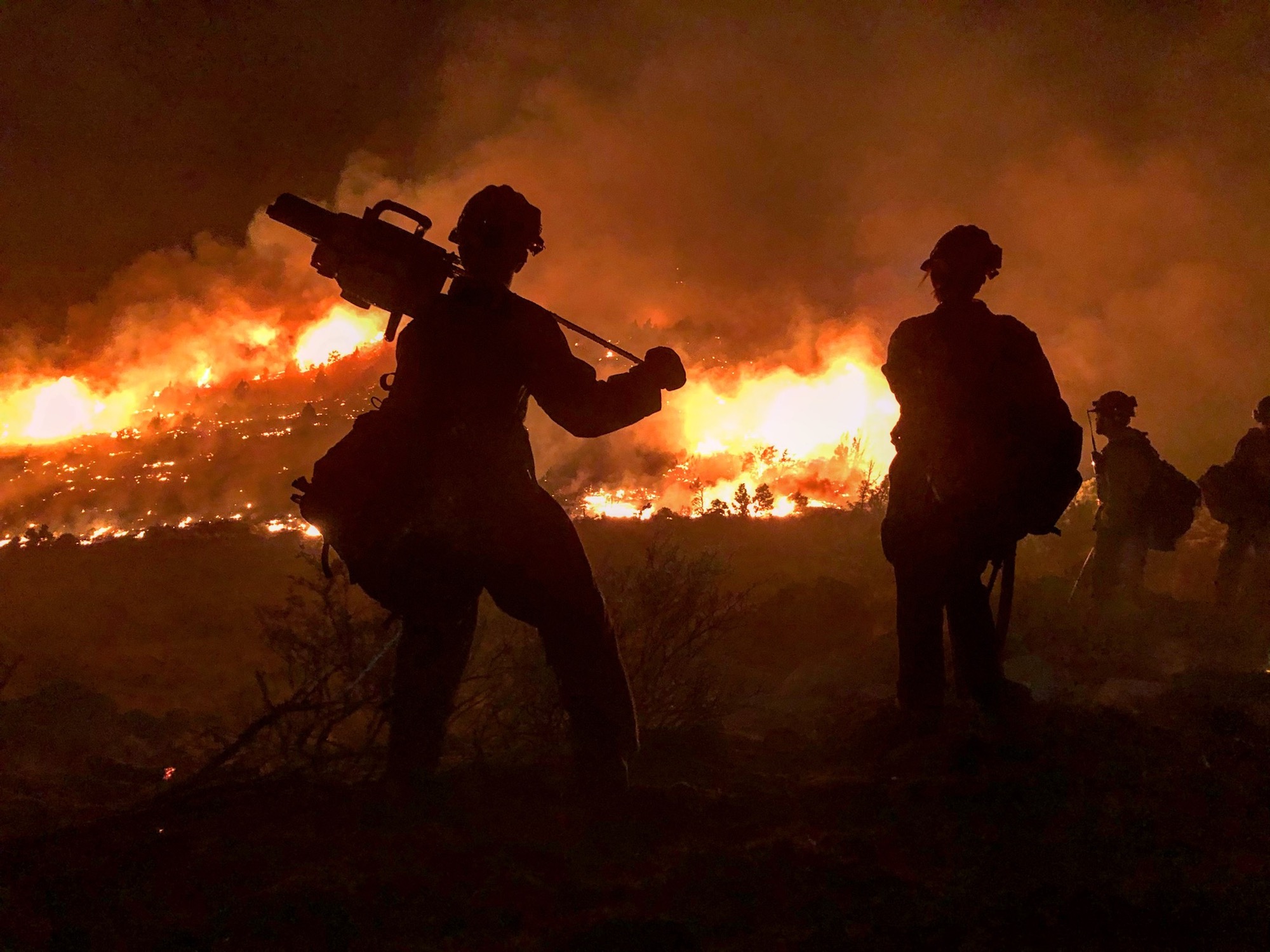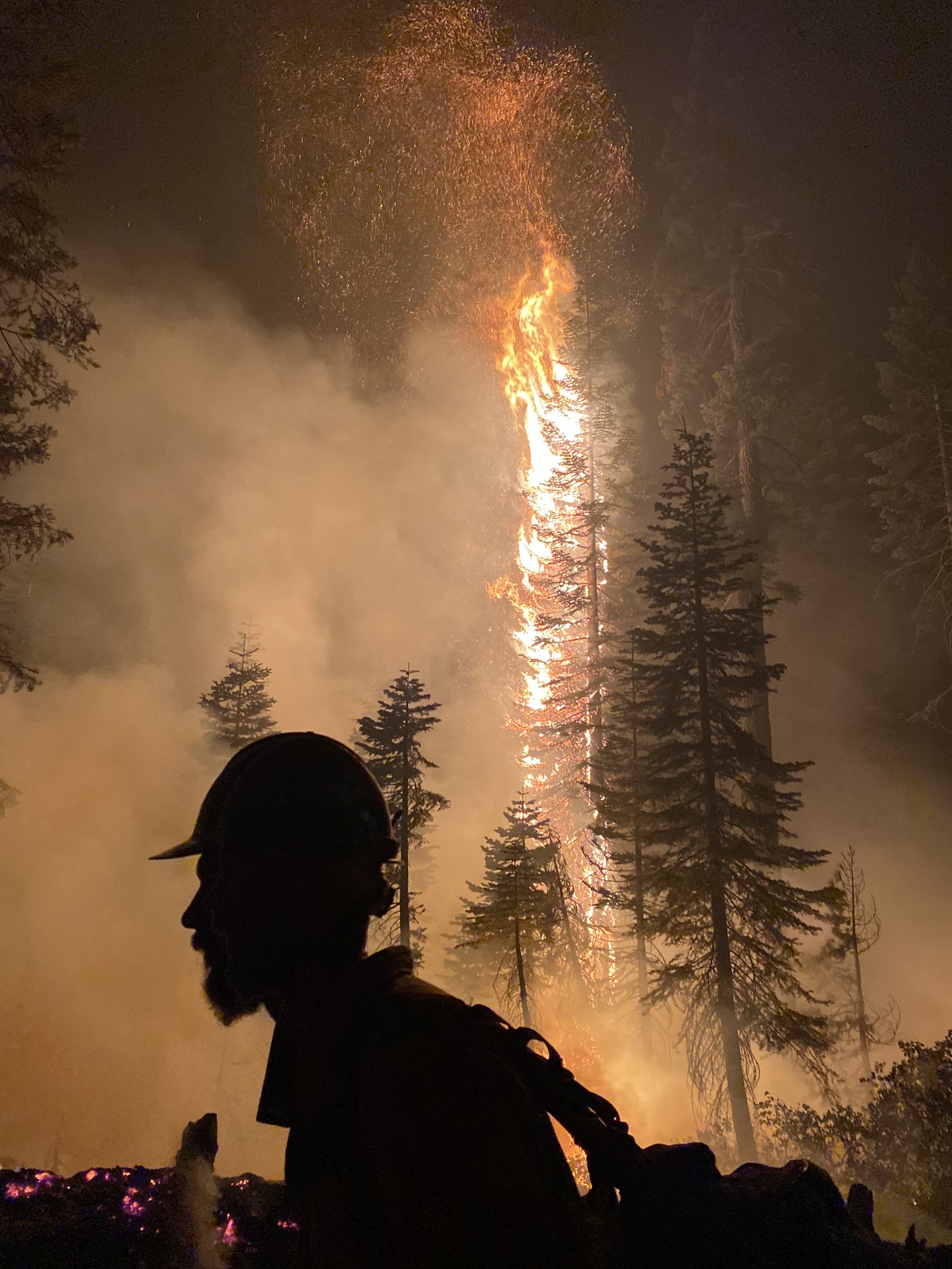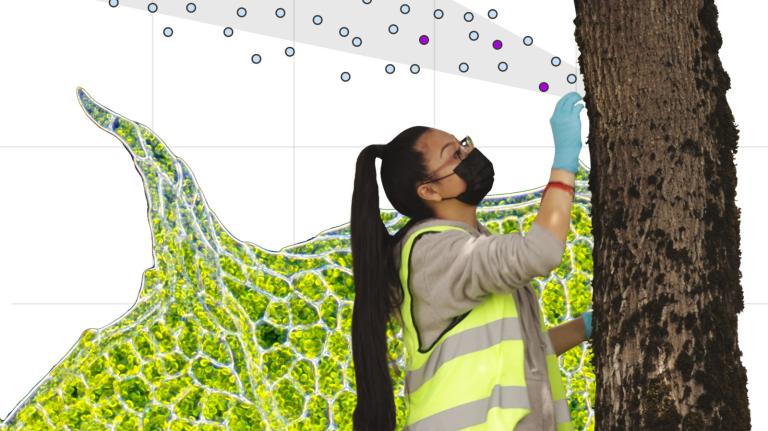Sometime in the blur of September 2020, I stood on a ridgeline in the Plumas National Forest in Northern California and watched as the year’s deadliest fire ripped nearly 30 miles down the Middle Fork of the Feather River. The northeast winds that fueled the blowout howled around me and the other members of my crew throughout our 18-hour shift, peeling hard hats from heads, cracking lips, sandblasting eyelids until they puffed shut around grit-scratched corneas.
It was the middle of my first season on a Forest Service Hotshot crew. We’d come up to the mountaintop in the early morning to catch a slopover, a point where the wind had brought fire across our containment lines. Though dawn had barely broken, it was already windier than I could ever remember a day being, and the flames were making fast angry lunges through patches of dense brush toward a stand of thick timber.
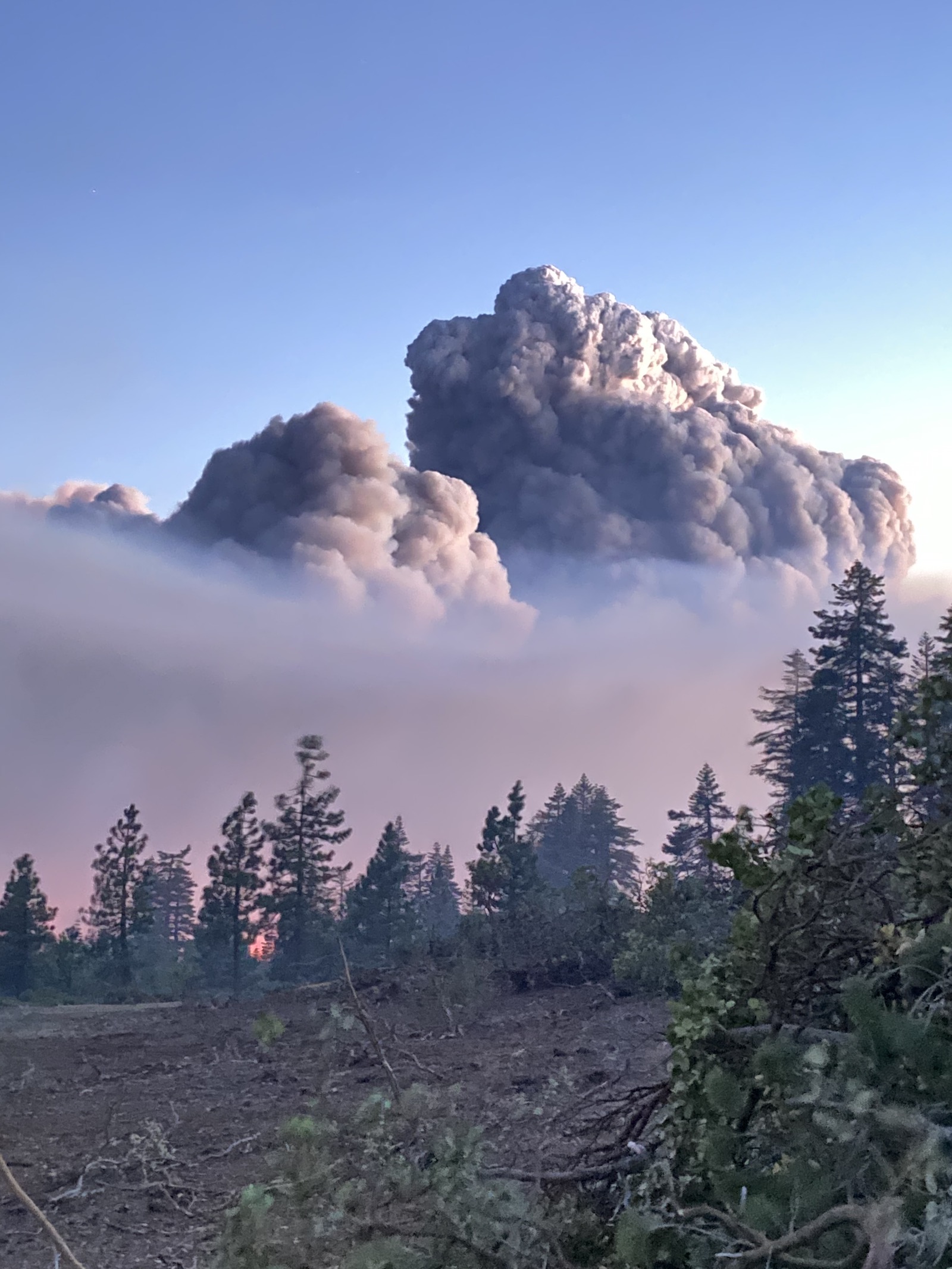
We caught the slop and lined it. If you don’t live near constant wildfire, you might not know what that means; we used saws and hand tools to clear the vegetation in a perimeter around the flames, depriving it of fuel. We were just spreading out to hold the line when a dark column began to materialize a couple of canyons away, chewing in on itself and boiling outward, erupting skyward like a particularly beautiful and untidy mushroom cloud. Above us, a veteran firefighter was scouting from a plane — a position also known as Air Attack — advising those of us on the ground below. It was hard to hear the radio over the wind, but I made out his firm suggestion that anyone in that area get out immediately.
Wildfire, a feature of California ecology since prehistory, has in recent years become a harsh and intrusive reality that the state struggles to reckon with. Climate change, rampant overgrowth of fuel, and an ever-expanding rural population make the job of wildland firefighters harder every year. But while wildfire as a concept has become familiar to Californians, the logistics of how fires are dealt with remain opaque, and understandably so. It is, as one might expect, a battle of much sweat and blood and a few tears on the part of firefighters. But it’s also one of exhaustive bureaucracy. Cal Fire, the state’s proprietary fire and medical response agency, tends to dominate media coverage and the public understanding of firefighting. But suppression and prevention of wildfires involve an extensive and interdependent network of different agencies.
Of the approximately 33 million acres of forest in California, 57 percent is administered by the federal government. Both on this land and off it, containment of wildfires falls to an assortment of agencies including the Forest Service, the Bureau of Land Management, the National Park Service, and the Bureau of Indian Affairs. Wildland firefighters who work for one of these federal agencies share a common plight: the pay is low and the benefits are scarce. That makes it hard to retain people. If you wonder why there might not be enough firefighters this summer, that’s one good reason why.
By some estimates, around 20 percent of permanent positions in federal firefighting went unfilled last year, and this can mean dangerously diminished efficacy on the fire line. Let me translate that: If you don’t take care of federal firefighters, you don’t understand what they do or who relies on them. It’s a failure to recognize the realities of fighting wildfires and the danger the blazes present to the public.
A couple days before the blowout, I was working a quiet spot with one of our saw teams, using chainsaws to clear debris, when a public information officer wandered up the line and asked to take our picture. Filthy and haggard, with 10 days’ worth of soot coating my face and staining my teeth, I demurred. He insisted, so I let him snap a picture of me talking into my radio. “Thanks,” he said. “You know, most of the public are really supportive, really appreciative, but you do get those ones who think you all are just out here sitting in the woods, collecting a paycheck.” In light of the summer we’d had, the idea was so patently absurd that we all laughed for a minute.

But he had a point. There’s a vague mythology of the Hotshot as a rugged and daring outdoorsman. Along with that comes another piece of fantasy: that all firefighters are well-paid, comfortably employed, and well-cared for. In reality, different firefighters have distinct responsibilities and capabilities, and wildly disparate levels of compensation.
It’s easy to get confused. There’s an alphabet soup of agencies at work on any given fire, and within them, countless different roles for an individual firefighter. Ask an average Californian what a Hotshot is, and they’ll probably tell you it’s a guy who works for Cal Fire and jumps out of helicopters. In reality, they’re members of highly qualified, self-sufficient crews based on land, almost all of whom work for federal agencies. Those people who jump out of planes into fires? They’re called smokejumpers, and they also work for the feds. So do around 15,000 other wildland firefighters, whose duties can vary from hand crews (frontline firefighters who use hand tools to maintain firelines) to helitack (wildland firefighters who specialize in the use of helicopters to suppress fire) to wildland fire modules (crews whose specialty is prescribed or controlled burns, as well as back burns, which deplete a fire of fuel).
These federal firefighters — or, as they’re officially known, forestry technicians — earn a fraction of the pay collected by their peers in other agencies. Entry-level salaries at Cal Fire or Pacific Gas and Electric, perhaps the closest analogues to the feds in terms of day-to-day work, are nearly double an average first-year salary for the Forest Service. That gap only widens as seniority increases. GS-3s, entry-level employees in federal fire, earn a base rate of around $13.50 per hour. A Hotshot superintendent, who’s responsible for the lives of their 20 crew members and required to hold a plethora of specialized qualifications accumulated over the course of at least a decade of experience, will enjoy a base rate of about $22.00 to $28.00 per hour.
Defenders of the federal agencies will be quick to note that the real money to be made in fire comes with overtime and hazard pay. But even with these pay bumps, forestry technicians won’t take home anything close to their state or municipal counterparts. And federal firefighters, who work infamously long hours, can be shortchanged on overtime. It’s sometimes unavoidable that unpaid time is spent on gear maintenance or preparation for the next shift, rather than sleeping and eating, and much of the pay increase forestry technicians earn for overtime is immediately lost to a higher tax rate.
Similarly, the “hazardous” distinction and its attendant pay raise apply only to officially designated incidents, not to prescribed burns, fuel reduction operations, or training exercises, all of which are perfectly capable of causing injury or death and have done so in a handful of tragic accidents. This is one of a few commonly derided policy loopholes that reduce the pay of forestry technicians. Another is the lack of an official on-call designation. When they’re not on fires, many federal firefighters are required to remain within a two-hour “call-back” radius of their station and be ready to report to duty at any time, but are paid neither for travel time nor any kind of on-call wage.
The low hourly rate earned by forestry technicians is also meted out very differently from the pay of their peers. On wildland incidents, Cal Fire and many other agencies are paid using a ‘“portal-to-portal” system. From the moment they leave their station’s door to the moment they return, they are being paid, 24/7.
Federal resources, on the other hand, are off the clock and unpaid between shifts, though they remain on-site at the fire for the duration of their 14-day assignments. The adoption of a portal-to-portal pay system by the federal agencies is a commonly proposed tactic to alleviate staffing problems, but so far, it’s failed to come to fruition. As of now, conventional wisdom among forestry technicians dictates that each summer, financial security comes only after working 1,000 hours of overtime, accrued in shifts ranging from 10 to 40 hours.
Hotshots lighting a controlled burn on the 2020 North Complex fire in Plumas National Forest, California. PC Paymon Kaeni
So it’s not surprising that the Forest Service and Bureau of Land Management are having trouble retaining firefighters. What’s shocking is how very little is being done about it. The federal agencies, which are budgeted through congressional appropriations, are given billions of dollars in discretionary funding for wildfire every year. That so little makes it into the hands of the men and women playing the most critical role in confronting wildfires seems like more than an oversight. It seems like negligence, and suggests the belief that any warm body is as good as the next on the fire line; that there is an unlimited supply of men and women willing to trade high risk for low wages.
The California Hotshot season starts in late spring with two weeks of intensive training, physical and otherwise. I spent the winter anxiously preparing for this initiation, deeply concerned that I wouldn’t make the cut. I ran 30 miles a week, did 200 pushups a day, crunched until my abs spasmed, and every few days took a 50-pound bag of coarse gravel for a long walk up a steep hill. On the day of our first crew hike, I felt some of the purest relief I’ve ever known that I wasn’t a straggler, with an irate lead firefighter shouting in my ear, “Pick it the FUCK up!”
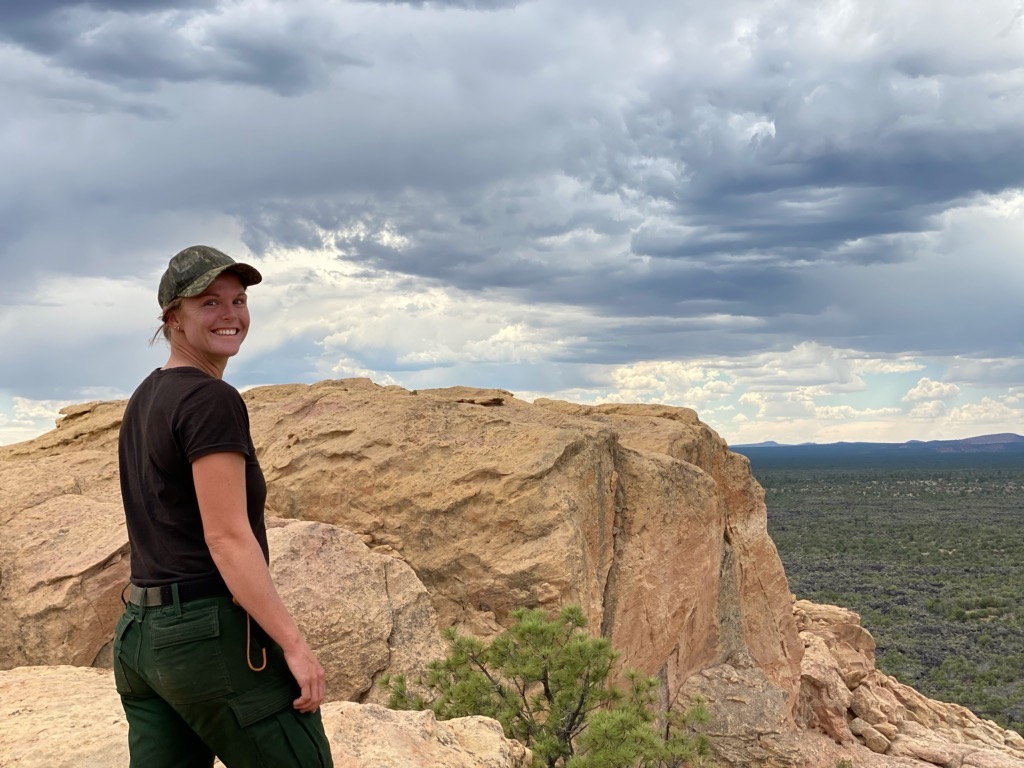
Fitness is a crucially important component of a successful Hotshot crew, but it’s far from the only one — and the idea that wildland firefighting consists solely of brute-force unskilled labor is a damaging misconception. Even relatively inexperienced members of a Type I crew are expected to be proficient in skills ranging from programming radios to repairing small engines to taking command of medical incidents.
The unpredictable nature of wildland firefighting requires adaptability and capability in a workforce, as well as the accumulation of years of knowledge and experience. The job can be extremely dangerous, and when this is the case, crews rely entirely on their leadership to keep them safe and working. I spent the season amazed that there aren’t more injuries and fatalities. Every time I reached across a chainsaw in a moment of exhausted carelessness or wrestled myself free from an impenetrable thicket of head-high manzanita shrubs I’d just set on fire around my own body, I felt like it was a small miracle that we all made it through our days. The presence of highly capable supervisors is the difference between fighting a fire effectively and letting it get away. It can also be the difference between life and death.
There are a lot of reasons I chose this job. I like being outside and feeling useful. I love a good sufferfest. I have a self-indulgent tendency towards itinerancy — it’s fun. Those are reason enough for someone in my position— a rookie in my 20s, free of financial burdens and real responsibilities. But this is the crux of the federal agencies’ struggle to meet their staffing needs. Among firefighters at the career stage most important to those agencies — those sharp, hardworking, and experienced enough to take on the responsibility of helping to run a crew— the myriad sacrifices the job requires increasingly outweigh its rewards. Public service and a dismal hourly rate can become fragile justifications for half-year chunks of absenteeism from the lives of spouses and children, not to mention the extreme toll on the bodies and minds of forestry technicians. Chronic injuries abound, as does psychological damage. I can’t cite hard numbers because the federal government does not compile them, but among wildland firefighters, there is ubiquitous acknowledgment of problematically high rates of divorce, chronic sleep problems, depression, PTSD, and suicide.
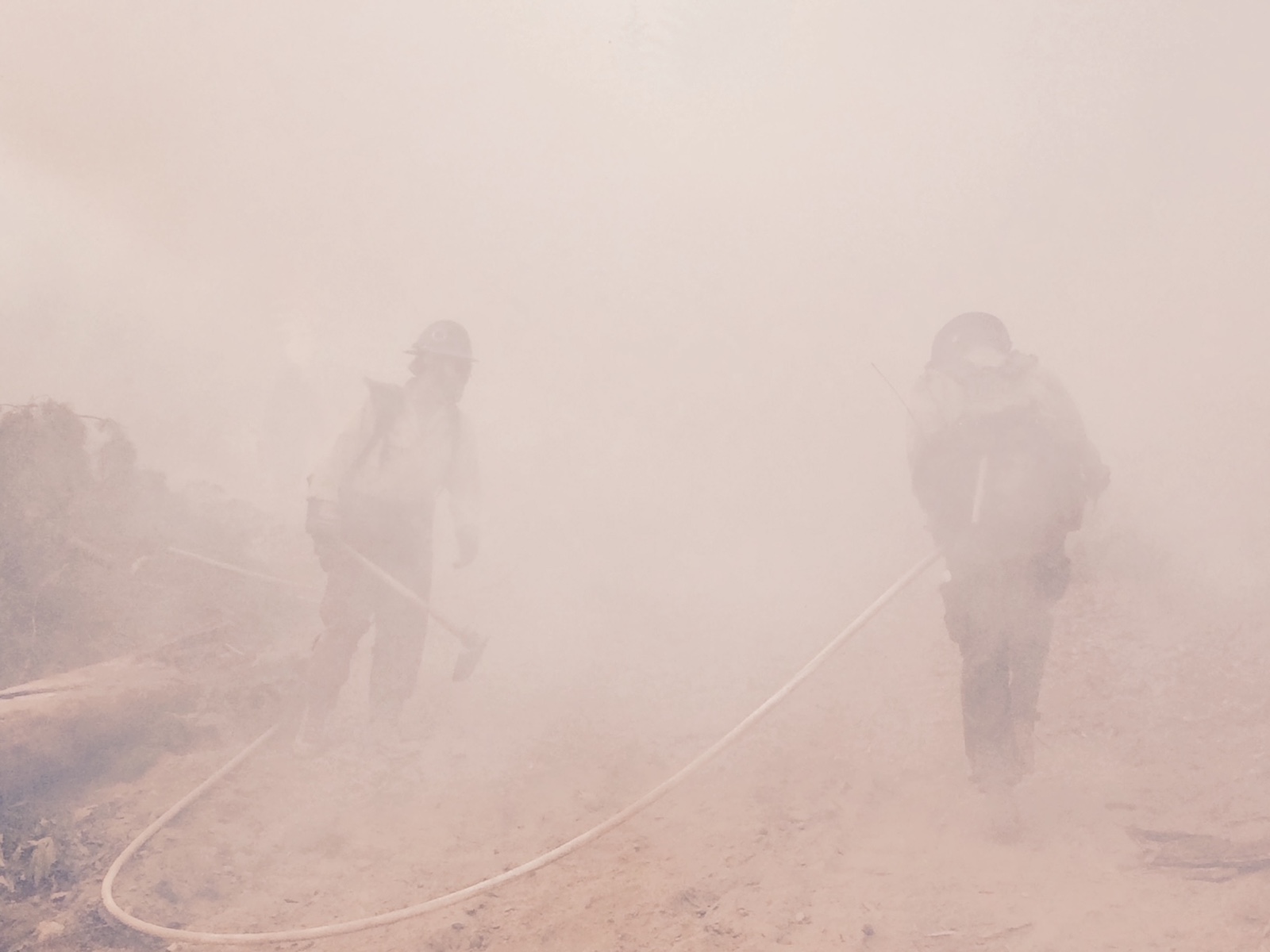
When federal firefighters are injured on the job, they can technically seek help from the Office of Workers’ Compensation Programs. But dealing with OWCP is universally acknowledged among crews to be a nightmare: Workers’ comp claims stagnate, unpaid, for years, and are regularly denied or botched to the point of being wholly ineffective. When firefighters die on the job, as they do every year, their families are left largely unsupported, grieving, and financially insecure. Where the federal government fails, nonprofits like the Wildland Firefighter Foundation pick up the slack, but that’s hardly a long-term or comprehensive solution. The WFF is funded largely by donations from other wildland firefighters and their families. In the end, it falls to forestry technicians to take care of each other.
The problems faced by federal firefighters are not widely recognized in large part because historically, they haven’t been discussed outside the insular world of wildfire. To complain is deeply antithetical to both the ends and means of the job; to be seen as a whiner is the worst of all possible sins. This ethos is not without purpose. The ability to accomplish a lot when given very little is, necessarily, the hallmark of federal firefighting.But as the cost of living in much of the West rapidly outstrips the wages earned by forestry technicians, they’re beginning to state their case more publicly. This summer, a Vice documentary team followed the El Dorado Hotshots around for a while, making the second installment of a series on wildland firefighting. Captains, superintendents, smokejumpers, and others have written an array of open letters to their peers and their agencies, describing the challenges they’ve faced during decades on the job — what has changed, and what, notably, hasn’t.

The Grassroots Wildland Firefighters, a group of current and former smokejumpers and Hotshots, is attempting to focus the ample energy of the federal firefighting community. Some of my crewmates sat in on a Zoom meeting with the GWF while on assignment this fall, during which a tired-sounding smokejumper explained over a crying kid in the background that the organization was advocating for title changes, adequate pay, and comprehensive well-being. They offer on-the-ground perspective and potential solutions to lawmakers, as well as ways for the public to get involved.
Even against the impenetrable monolith of federal bureaucracy, forestry technicians are ready to do what they do best: solve problems. Unfortunately, this is a problem only the federal government can solve.
There’s certainly precedent for the type of overhaul that many forestry technicians are hoping for. Firefighters today are the beneficiaries of decades’ worth of hard-won labor reforms, from the provision of sleeping bags and hot meals to boot stipends, work-to-rest requirements, and the now-standard 14-day assignment. In the early 2000s, Region 5, which covers California, was able to provide retention bonuses for forestry technicians without congressional approval. This policy saw some success in slowing attrition in the federal fire workforce, but since its expiration in 2011, retention problems have redoubled and crept into other regions, underscoring the need for permanent, agency-wide solutions.
Unfortunately, those larger-scale reforms are contingent on a cumbersome series of federal approvals. When forestry technicians or their union, the National Federation of Federal Employees, manage to bring a policy update before Congress, the change must be approved not only by the legislature, but also by the U.S. Office of Personnel Management and the U.S. Office of Management and Budget. This three-step approval can take years, and, depending on the political climate, might not happen at all.
Other, similarly hamstrung federal workers have turned to strikes to effect change. But federal wildland firefighters couldn’t organize a general strike, and not just because they’re contractually prohibited from doing so. To strike during fire season would be, for obvious reasons, ethically fraught, and a winter strike seems unlikely to muster much bargaining power.
It’s clear though that the problems facing forestry technicians are not inevitable or unchangeable. The ”it is what it is” philosophy doesn’t hold up under scrutiny. It is what it is, until it isn’t.
Or, to borrow a line from the crew: Can’t lives on Won’t street.
In October 2020, we spent an assignment on the Red Salmon Complex, a fire that stretched across the Six Rivers and Klamath National Forests in Northern California, near the Oregon border. It had been burning since the middle of summer; in this unprecedentedly busy season, there simply weren’t enough resources to contain it. Colder weather had come to the Coast Range, the relative humidity was recovering overnight, and the fire behavior was mellow compared to what we’d been working with for months.

When the conditions were good, we burned green pockets out of the mountains above the Salmon River, the flames spitting flurries of gold and red leaves above us as we dragged our torches. We scrambled down the slick black boulders of tributaries, shooting flares from a .22 to burn the understory where the canyon walls were too steep to walk. On day 14, as we drove out of the canyon, high on the banks of the Salmon, I watched helicopters thrum down to the river below us to fill their buckets and sideslip up the canyon towards their targets, trailing shining drops.
Over the course of this assignment, a few of the guys brought up the Wildland Firefighter Recognition Act, a bill introduced a couple months earlier by Republican Representative Doug LaMalfa, whose congressional district covers much of the interior of Northern California. The act proposed a change of our title, from “forestry technician” to “wildland firefighter.” The rebrand would come with a new occupational series of positions for federal firefighters and an unspecified pay bump “based on the unusual physical hardship or hazardous nature of the position.” A prior iteration of the bill died in Congress in 2019, in a session held squarely between the two worst fire seasons in modern American history.
The bill’s reintroduction wasn’t the only political attention the unprecedented strain of the 2020 fire season garnered. In October, probably while my crewmates and I were burning on the Klamath, then-Senator Kamala Harris sent a letter to the secretaries of the Interior and Agriculture departments, advocating on behalf of federal wildland firefighters. And this past April, the House Subcommittee on National Parks, Forests, and Public Lands held a hearing that at least attempted to confront some of federal fire’s problems. Riva Duncan, a former fire staff officer and the executive secretary of the Grassroots Wildland Firefighters, gave impassioned testimony on the challenges she’s grappled with during more than three decades with the Forest Service, and the dire need for change.
It’s certainly unusual for now-Vice President Harris to come down on the same side of an issue as LaMalfa, a staunch conservative who represents one of California’s reddest (and most fire-prone) districts. Reform in the name of federal firefighters seems to present a rare opportunity for bipartisan progress in Washington.
All this constitutes an unprecedented level of engagement with the challenges wildland firefighters have faced for decades. Congress and agency administrators are beginning to confront the reality they have so far struggled to grasp. There’s a steep cost, both financially and functionally, associated with training a new and inexperienced forestry technician to replace one who has moved on.
Ultimately, that cost is borne by the public. A shortage of federal firefighters has a predictable and devastating outcome: towns and wilderness throughout the American West won’t be adequately protected. But whether all the politicking will incur meaningful reform remains to be seen.
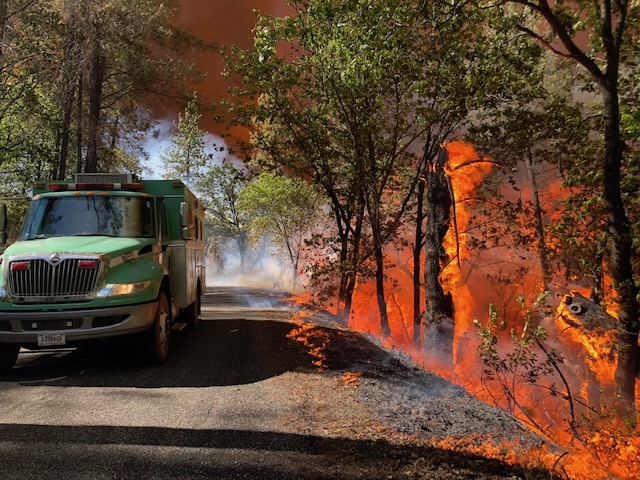

Left: A buggy, sometimes called a crew haul, passes through a hot area during the summer of 2017. Right: Captain Elsa Gaule burns off a section on the 2017 Eclipse Complex fire in the Klamath National Forest. Photos courtesy of PC Elsa Gaule (left) PC Tobias Moralez (right)
The day after the blowout on the Bear Fire, one of our leads was hit by the top of a tree. He was on his own, down in a steep drainage, orchestrating a handful of helicopters to cool down a leading edge of the fire and give the rest of us time to prepare a road to burn off. He didn’t see the dead top of the tree, or hear it fall. He’s lucky to be alive.
The piece that hit him was large enough to be fatal, but decomposed enough to break on impact. It smashed him down the steep hill he was working on, filling pockets on his pack with rot and woodchips. He’s been in wildland fire for most of his adult life and has had plenty of close calls, but this one was enough to make him call his mom, just to say hi.
On our way back to camp that evening, after he hiked out of the ravine and rejoined the crew, he mentioned the incident so casually that it took me a moment to register what he was saying. Tree strikes are killers, the stuff of nightmares, and he spoke with the blasé manner of someone describing how he’d been cut off in traffic.
As he told the story, we laughed and joked, glad he was OK. But the exchange left me sobered and bewildered. After a decade of experience, the accumulation of innumerable specialized skills, and the consistent risk of his life and his health, he still only merits the title of “forestry technician,” and an hourly pay rate comparable to a senior barista at my local Starbucks. There’s a damaging disconnect between the lionized figure of the firefighter and the reality of the men and women who fight more fire than anyone.

